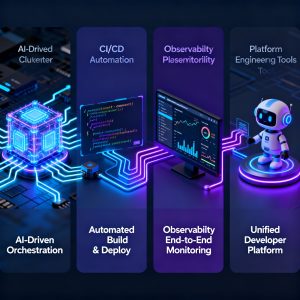Modern software development evolves at an astonishing pace. Product teams demand faster feature releases, stakeholders expect higher efficiency, and quality assurance (QA) teams are under pressure to guarantee reliability. Yet traditional testing methods—manual reviews and brittle automation scripts—often slow down delivery and hinder innovation.
The emergence of artificial intelligence (AI) and generative tools like ChatGPT, Gemini, Claude, and others marks a turning point. These technologies move software testing from reactive validation toward intelligent, predictive quality management. Backed by recent research, AI‑driven QA is proving to be faster, more accurate, and more adaptive—ushering in the era of intelligent testing.
The Evolution of Software Testing
To understand this transformation, it helps to trace the journey of QA through its three key eras.
Manual Testing – The Traditional Approach
Human‑led testing fosters creativity but fails to scale. Repeated regression cycles result in “test debt,” slowing production and increasing overlooked defects. Manual testing represents precision without speed.
Automation Testing – The Script Bottleneck
Tools like Selenium and Cypress enabled continuous integration and faster validation. Yet small interface changes—like a renamed button—could break entire test suites. Studies show that QA teams spend over 70% of their time maintaining test scripts instead of finding new bugs. Automation brought speed, but not resilience.
AI‑Powered Testing – The New Standard
AI changes the equation entirely. By applying machine learning (ML) and natural language processing (NLP), intelligent testing frameworks not only execute tests but also learn continuously from code patterns and project history. Predictive analytics identify where errors are most likely and reduce redundant test runs.
| Feature | Manual Testing | Automation Scripts | AI‑Powered Testing |
|---|---|---|---|
| Speed | Slow | Fast | Real‑time adaptive |
| Maintenance | Moderate effort | High (frequent fixes required) | Low (self‑healing automation) |
| Accuracy | Variable (human error) | High but fragile | Predictive and adaptive |
| Learning Capability | None | None | Continuous learning |
| Scalability | Low | Medium | High |
The Data‑Driven Impact of AI in Software Development
A 2024 GitHub study across 179 countries revealed dramatic growth in developer productivity following ChatGPT adoption:
- +899 more code commits per 100,000 users
- +1,657 new projects created
- +578 first‑time contributors joining development communities
This surge demonstrates that AI boosts coding velocity and innovation worldwide, particularly in languages like Python and JavaScript, which suit LLM‑based autocompletion and function generation.
For QA leaders, these metrics confirm that AI isn’t just a productivity enhancement—it’s now a critical business investment.
How AI and ChatGPT Streamline Testing
New AI testing systems are improving quality assurance at every stage—from test creation to analysis.
Automated Test Case Generation
Generative models can parse natural‑language requirements and instantly produce structured test cases or full automation scripts. Tools like ChatGPT and Gemini convert business rules into BDD/Gherkin steps compatible with Cypress or Playwright, drastically cutting setup time.
Self‑Healing Automation Scripts
Traditional tests often break after UI updates. AI mitigates this using visual recognition and contextual matching instead of static element IDs. When a developer changes a button’s name or icon, AI automatically detects it and repairs the script—a concept known as “self‑healing automation.”
As noted in industry research, this shift can reduce maintenance workloads by more than 60%, accelerating release cycles dramatically.
Smarter Debugging with LLMs
AI accelerates root‑cause analysis by linking log data, code diffs, and test failures. In controlled studies, ChatGPT and BingAI solved complex issues in niche languages like Scala, identifying errors and proposing repairs in seconds that previously took hours.
Predictive and Metamorphic Testing
Modern models also enable testing techniques like metamorphic testing, where AI generates logical rules (“metamorphic relations”) for systems without clear expected outputs. GPT‑4, for example, successfully created innovative relations for previously untested systems—proof that AI can not only replicate but also expand existing testing strategies.
The Human Factor: Quality Beyond the Algorithm
Despite AI’s enormous value, human oversight remains essential.
AI’s Speed vs. Human Judgment
While models like ChatGPT accelerate test generation, the code they output often requires significant revision to meet industry standards. QA professionals still provide indispensable critical thinking, domain understanding, and ethical oversight—roles automation cannot replace.
The Rise of the Quality Architect
In the hybrid future, human testers evolve into Quality Architects—professionals who guide, validate, and interpret AI decisions. Their responsibilities include:
- Prompting AI for targeted test coverage scenarios
- Reviewing automated outputs and ensuring integration reliability
- Conducting human‑centric exploratory testing focused on user experience and accessibility
- Ensuring compliance, privacy, and responsible AI use
Addressing the New Risks
As AI becomes integral to testing, safeguarding intellectual property and sensitive data is paramount. Engineers increasingly sanitize proprietary information before interacting with public models. Forward‑thinking organizations are therefore adopting enterprise AI platforms with data‑isolation guarantees or deploying internal models for secure in‑house use.
The ethical dimension—from bias detection to consent in AI outputs—also demands proactive governance and continuous auditing.
The Strategic Mandate: Building Human‑AI Collaboration
The integration of AI doesn’t eliminate QA teams—it transforms them. Routine validation gives way to intelligent orchestration, freeing humans to focus on creative and ethical challenges.
Key recommendations for engineering leaders:
- Adopt smart testing tools that embed AI at every stage of QA.
- Upskill testers to operate as AI validators and quality architects.
- Balance automation with judgment by maintaining human checkpoints in the pipeline.
- Establish AI‑governance frameworks that protect privacy and guarantee data compliance.
AI amplifies output—but humans ensure excellence.
Conclusion
The rise of AI and ChatGPT marks the end of tedious, manual software testing. Neural networks now heal broken test scripts; language models translate requirements into code; predictive analytics flag vulnerabilities before they occur.
Yet the core principle remains: testing exists to ensure human confidence. The most future‑ready teams will be those that treat AI not as a replacement but as a collaborator—leveraging automation for efficiency while relying on human intelligence to define quality, trust, and ethics.
The future of testing is intelligent, integrated, and profoundly human‑driven.
Read more such articles from our Newsletter here.



